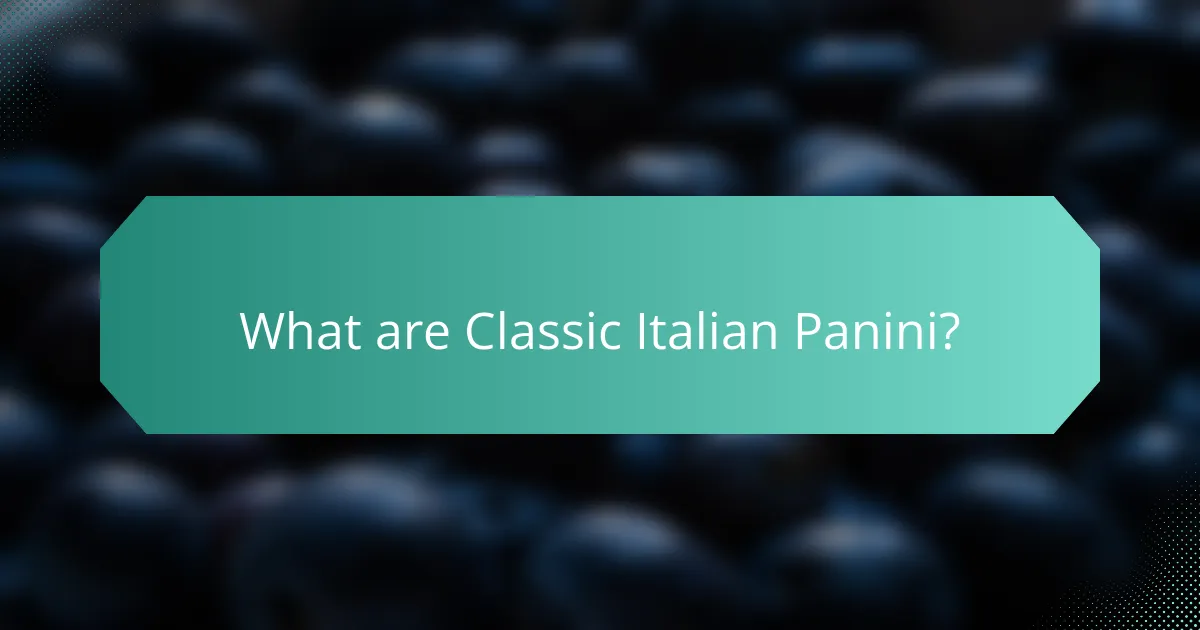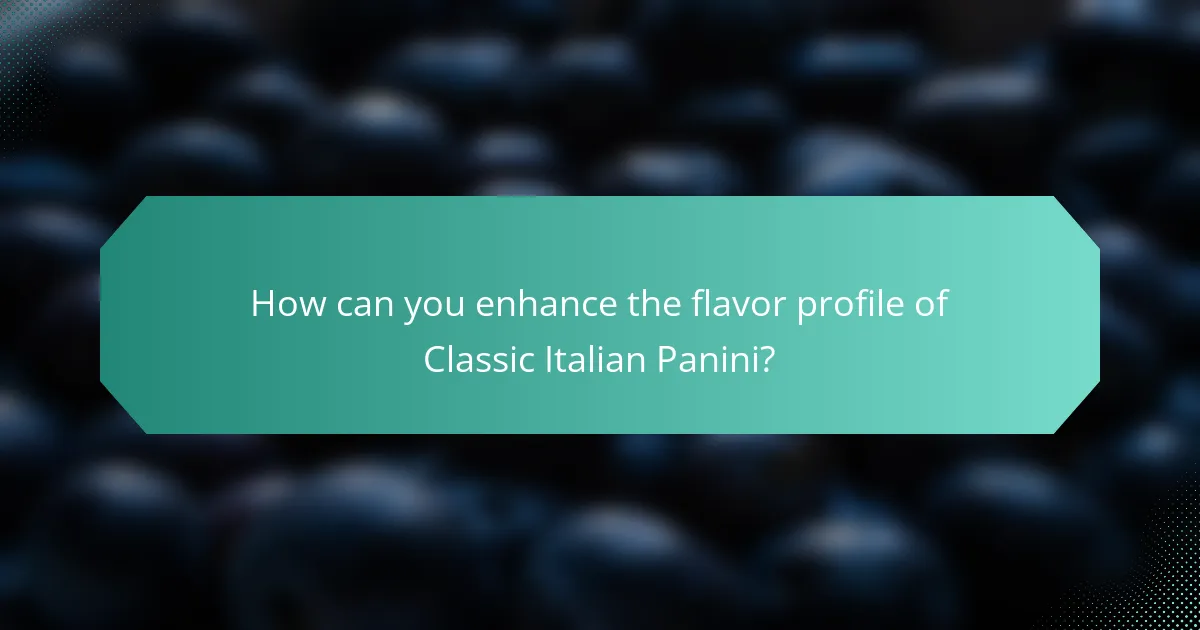
What are Classic Italian Panini?
Classic Italian Panini are grilled sandwiches made with Italian bread. They typically contain various fillings, such as meats, cheeses, and vegetables. The bread is often ciabatta or focaccia, known for its crusty exterior and soft interior. Panini are pressed and toasted, creating a warm, crispy texture. Originating in Italy, these sandwiches are popular for their versatility and flavor. They can be enjoyed as a snack or a meal. The preparation method enhances the ingredients’ flavors, making them a favorite in Italian cuisine.
How are Classic Italian Panini different from other sandwiches?
Classic Italian Panini differ from other sandwiches primarily in their preparation and ingredients. Panini are made using specific types of bread, typically ciabatta or focaccia, which are pressed and grilled. This method creates a distinct crispy exterior while maintaining a soft interior.
In contrast, many other sandwiches may use a variety of breads without the grilling process. The fillings in Classic Italian Panini often include high-quality Italian meats, cheeses, and fresh vegetables, emphasizing authentic Italian flavors.
Additionally, the grilling technique used for Panini enhances the melding of flavors, which is not always the case in other sandwich types. The focus on quality ingredients and specific preparation methods sets Classic Italian Panini apart from standard sandwiches.
What defines the traditional aspects of Classic Italian Panini?
Classic Italian Panini are defined by their use of specific ingredients and preparation techniques. Traditional panini typically feature ciabatta or focaccia bread. These breads are known for their crusty exterior and soft interior. The fillings often include cured meats, cheeses, and vegetables. Common meats are prosciutto, salami, and mortadella. Cheeses like mozzarella and pecorino are frequently used. Fresh ingredients such as basil and arugula add flavor.
The preparation involves grilling the sandwich, which creates a crispy texture. Pressing the sandwich while grilling enhances the melding of flavors. Authentic panini are often served with a drizzle of olive oil. This adds richness to the overall taste. The combination of quality ingredients and grilling technique defines the classic Italian panini experience.
What are the cultural origins of Classic Italian Panini?
Classic Italian Panini originated in Italy, particularly from the regions of Tuscany and Liguria. These sandwiches are traditionally made with ciabatta or focaccia bread. The term “panini” means “small breads” in Italian. Panini became popular in Italian cafés and bars as a convenient meal option. The practice of grilling sandwiches dates back to the early 20th century in Italy. Italian immigrants brought this culinary tradition to various countries. Over time, panini have evolved with diverse fillings and preparation methods. Today, they are enjoyed globally, reflecting both Italian heritage and local adaptations.
What are the essential ingredients in Classic Italian Panini?
Classic Italian Panini typically includes ciabatta or focaccia bread. The bread is often grilled to achieve a crispy texture. Essential fillings include various meats like prosciutto, salami, or mortadella. Cheese, such as mozzarella or provolone, is commonly added for flavor. Fresh vegetables like arugula or roasted peppers enhance the taste. Olive oil and balsamic vinegar may be used for added richness. These ingredients combine to create a flavorful and satisfying sandwich.
What types of bread are used for Classic Italian Panini?
Ciabatta and focaccia are the primary types of bread used for Classic Italian Panini. Ciabatta features a rustic, chewy texture with a crispy crust. It is ideal for holding fillings without becoming soggy. Focaccia, on the other hand, is softer and thicker, providing a different mouthfeel. Both breads are traditional in Italian cuisine and are commonly used in sandwich-making. Their unique textures enhance the overall flavor experience of the Panini.
What fillings are commonly found in Classic Italian Panini?
Classic Italian Panini commonly feature fillings such as prosciutto, mozzarella, and basil. Other popular ingredients include salami, roasted peppers, and arugula. These fillings are chosen for their complementary flavors. The combination of savory meats and fresh cheeses creates a balanced taste. Additionally, the use of fresh herbs enhances the overall flavor profile. Panini are often pressed and grilled to achieve a crispy exterior. This method helps meld the flavors of the fillings. Classic Italian Panini are a staple in Italian cuisine, showcasing traditional ingredients.
How do preparation methods impact Classic Italian Panini?
Preparation methods significantly influence the texture and flavor of Classic Italian Panini. Grilling creates a crispy exterior while keeping the interior warm and melty. The use of a press ensures even cooking and optimal compression of ingredients. Toasting enhances flavors through caramelization, particularly in the bread. Additionally, different oils or butters can impart unique flavors during cooking. The choice of preparation method can also affect the overall moisture content, impacting the sandwich’s mouthfeel. For instance, steaming can retain more moisture, while grilling may lead to a drier texture. Each method contributes distinct characteristics, shaping the final experience of the Panini.
What techniques are used to grill Classic Italian Panini?
Classic Italian Panini are grilled using techniques such as pressing and toasting. The panini is typically placed in a panini press or grill. This equipment applies heat and pressure simultaneously. The pressing technique ensures even grilling and a crispy exterior. Toasting helps melt the cheese and warm the fillings. The grill marks enhance the visual appeal. Additionally, using a medium heat allows for thorough cooking without burning. These techniques result in a deliciously grilled panini with a satisfying texture.
How does the cooking time affect the flavor and texture of Classic Italian Panini?
Cooking time significantly influences the flavor and texture of Classic Italian Panini. Longer cooking times create a crispier exterior while enhancing the toasty flavor. The heat allows the cheese to melt thoroughly, contributing to a creamy texture. Insufficient cooking time results in a soggy panini with a less developed flavor. Ideally, panini should be cooked for 3 to 5 minutes on medium heat. This duration balances the crispiness of the bread with the warmth of the fillings. A well-cooked panini should have a golden-brown crust and a soft, warm interior.

How can you enhance the flavor profile of Classic Italian Panini?
To enhance the flavor profile of Classic Italian Panini, incorporate high-quality ingredients. Use fresh basil for a fragrant herbal note. Add sun-dried tomatoes for a tangy sweetness. Include aged cheeses like Parmigiano-Reggiano for depth. Experiment with different meats, such as prosciutto or salami, for richness. Drizzle with balsamic reduction for added acidity. Use artisanal bread to elevate texture and flavor. Toast the panini until golden brown for a crispy exterior. These enhancements create a more complex and satisfying flavor experience.
What role do seasonings and condiments play in Classic Italian Panini?
Seasonings and condiments are essential for enhancing the flavor of Classic Italian Panini. They provide depth and complexity to the sandwich’s taste profile. Common seasonings include salt, pepper, and Italian herbs like oregano and basil. These ingredients elevate the overall flavor, making it more vibrant. Condiments such as olive oil, balsamic vinegar, and pesto add moisture and richness. They also contribute unique flavors that complement the fillings. The balance of seasonings and condiments is crucial for achieving a well-rounded taste. Classic Italian Panini often showcases regional variations in these ingredients, reflecting local culinary traditions.
What are the most popular condiments for Classic Italian Panini?
The most popular condiments for Classic Italian Panini include pesto, balsamic vinegar, and olive oil. Pesto adds a rich, herbaceous flavor that complements various fillings. Balsamic vinegar provides a sweet and tangy contrast, enhancing the overall taste. Olive oil is often drizzled for added richness and moisture. These condiments are commonly used in traditional recipes, contributing to the panini’s flavor profile. Their popularity is rooted in Italian culinary traditions, where fresh and flavorful ingredients are prioritized.
How do different cheeses influence the taste of Classic Italian Panini?
Different cheeses significantly influence the taste of Classic Italian Panini. Each cheese adds unique flavors and textures. For instance, mozzarella provides a creamy and mild taste, enhancing the overall balance. Provolone offers a sharper flavor, adding depth to the sandwich. Parmesan contributes a nutty and salty profile, intensifying the taste experience. Ricotta adds a rich creaminess, which complements other ingredients. Fontina melts beautifully and introduces a buttery flavor, enriching the panini. The choice of cheese impacts the overall flavor, texture, and mouthfeel of the panini. Thus, selecting the right cheese is crucial for achieving the desired taste in Classic Italian Panini.
What are some popular variations of Classic Italian Panini?
Popular variations of Classic Italian Panini include the Caprese Panini, which features fresh mozzarella, tomatoes, and basil. Another variation is the Prosciutto and Arugula Panini, combining savory prosciutto with peppery arugula. The Chicken Pesto Panini is also popular, often made with grilled chicken and basil pesto. Additionally, the Italian Meat Panini includes a mix of salami, mortadella, and provolone cheese. Each variation showcases distinct Italian flavors and ingredients. These combinations are commonly found in Italian cafes and restaurants.
How do regional differences affect Classic Italian Panini recipes?
Regional differences significantly affect Classic Italian Panini recipes. Each region in Italy has its own unique ingredients and culinary traditions. For example, Northern regions often use rich cheeses like Fontina and cured meats such as speck. Conversely, Southern regions favor fresh tomatoes, mozzarella, and spicy salami.
The bread used also varies by region. In Tuscany, unsalted bread is common, while in Liguria, focaccia is preferred. These choices impact the overall flavor and texture of the Panini.
Additionally, local herbs and spices influence the seasoning of the fillings. For instance, basil is prevalent in the South, while sage is more commonly used in the North.
These regional variations create a diverse array of Panini styles across Italy, reflecting local tastes and traditions.
What unique ingredients can be added to create gourmet Classic Italian Panini?
Unique ingredients that can be added to create gourmet Classic Italian Panini include truffle oil, fig jam, and prosciutto di Parma. Truffle oil enhances the savory flavor profile with an earthy aroma. Fig jam adds a sweet contrast, balancing the saltiness of cured meats. Prosciutto di Parma provides a rich, delicate taste, elevating the overall gourmet experience. Other unique options are fresh burrata cheese, arugula, and roasted red peppers. Burrata offers a creamy texture, while arugula contributes a peppery bite. Roasted red peppers add sweetness and depth, creating a well-rounded flavor. These ingredients transform a traditional panini into a gourmet delight.

What are the best practices for making Classic Italian Panini at home?
To make Classic Italian Panini at home, use high-quality ingredients and proper techniques. Start with fresh ciabatta or focaccia bread. Slice the bread horizontally for even grilling. Choose flavorful fillings like prosciutto, mozzarella, and basil. Layer ingredients evenly to avoid uneven cooking. Preheat a panini press or skillet for optimal heat distribution. Use moderate pressure when grilling to achieve a crispy exterior. Cook until the cheese melts and the bread is golden brown. Serve immediately for the best texture and flavor.
How can you ensure a perfect grill on your Classic Italian Panini?
To ensure a perfect grill on your Classic Italian Panini, preheat the grill to medium-high heat. Use a panini press or a heavy skillet for even grilling. Lightly oil the grill or the panini to prevent sticking. Place the panini on the grill and apply gentle pressure for uniform cooking. Grill each side for 3-5 minutes until golden brown and crispy. Monitor the internal temperature to ensure the cheese is melted and fillings are heated through. A perfect panini should have a crunchy exterior and a warm, gooey interior.
What tips can improve the overall quality of your Classic Italian Panini?
Use fresh, high-quality ingredients for your Classic Italian Panini. Fresh ciabatta or focaccia enhances texture and flavor. Select premium meats like prosciutto or salami for authentic taste. Incorporate aged cheeses such as Parmigiano-Reggiano for depth. Use fresh basil or arugula for added freshness. Grill the panini until golden brown for optimal crunch. Maintain even pressure while grilling for uniform heating. Allow the panini to rest briefly before cutting to prevent sogginess. These tips ensure a flavorful and satisfying panini experience.
How do you store leftover Classic Italian Panini for later consumption?
To store leftover Classic Italian Panini for later consumption, wrap each panini tightly in plastic wrap or aluminum foil. This method prevents moisture loss and keeps the panini fresh. Place the wrapped panini in an airtight container or a resealable plastic bag. Ensure the container is sealed properly to minimize air exposure. Store the panini in the refrigerator if you plan to consume them within a few days. For longer storage, freeze the wrapped panini. They can last up to three months in the freezer. When ready to eat, reheat the panini in a toaster oven or skillet for best results. This method retains the texture and flavor of the panini.
What common mistakes should you avoid when making Classic Italian Panini?
Using low-quality bread is a common mistake when making Classic Italian Panini. Authentic panini require crusty, fresh bread to hold the fillings and provide texture. Overstuffing the panini is another mistake. Too many ingredients can lead to a messy sandwich that doesn’t grill well. Not preheating the grill or panini press properly can also result in uneven cooking. Additionally, neglecting to use enough oil or butter can cause the bread to stick and not achieve a golden crust. Lastly, skipping the pressing step can prevent the panini from forming its signature shape and texture. These mistakes can compromise the overall taste and experience of the panini.
How can improper ingredient choices affect your Classic Italian Panini?
Improper ingredient choices can significantly compromise the quality of a Classic Italian Panini. Using stale bread can lead to a dry and unappetizing texture. Substituting authentic Italian cheeses with processed alternatives diminishes flavor complexity. Low-quality meats can result in a lack of depth and richness in taste. Additionally, incorrect seasoning can alter the intended flavor balance. For example, excessive salt can overpower the natural ingredients. Poor vegetable choices, like wilting produce, can negatively affect freshness. Each ingredient plays a crucial role in achieving the traditional flavor profile. Therefore, careful selection is essential for a successful Classic Italian Panini.
What grilling errors can ruin the texture of Classic Italian Panini?
Grilling errors that can ruin the texture of Classic Italian Panini include using too high heat. Excessive heat can lead to burnt bread and unevenly melted cheese. Another error is insufficient pressing during grilling. This can result in a soggy texture rather than a crisp exterior. Uneven grilling is also problematic. It can create areas that are overcooked while others remain undercooked. Additionally, using low-quality bread can negatively affect the panini’s texture. High-quality bread provides the necessary structure and flavor. Lastly, not allowing the panini to rest after grilling can lead to a loss of crispness. Resting allows steam to escape, enhancing the overall texture.
Classic Italian Panini are grilled sandwiches made with ciabatta or focaccia bread, filled with high-quality meats, cheeses, and vegetables. This article explores the unique preparation methods that distinguish panini from other sandwiches, emphasizing the importance of ingredient quality and grilling techniques. Key topics include traditional ingredients, regional variations, popular fillings, and best practices for making panini at home, along with tips to enhance their flavor profile. Additionally, the article addresses common mistakes and grilling errors that can impact the final product, ensuring a comprehensive understanding of Classic Italian Panini.